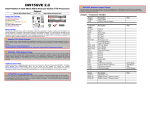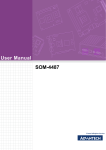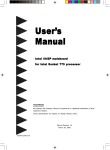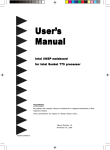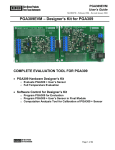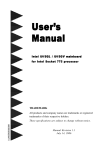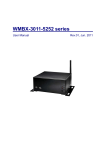Download P4 Socket 775 Motherboard
Transcript
P4 Socket 775 Motherboard IN915GVE User’s Manual http://www.bcmcom.com Declaration USER’S NOTICE COPYRIGHT © OF THIS MANUAL BELONGS TO THE MANUFACTURER. NO PART OF THIS MANUAL, INCLUDING THE PRODUCTS AND SOFTWARE DESCRIBED IN IT MAY BE REPRODUCED, TRANSMITTED OR TRANSLATED INTO ANY LANGUAGE IN ANY FORM OR BY ANY MEANS WITHOUT WRITTEN PERMISSION OF THE MANUFACTURER. THIS MANUAL CONTAINS INFORMATION NECESSARY TO USE OF IN915GVE MOTHER-BOARD AND WE HAVE TRY TO INCLUDE IN THIS MANUAL AS MANY INFORMATION AS POSSIBLE, BUT WE RESERVE RIGHT TO CHANGE, UPDATE ANYTIME WITHOUT PRIOR NOTICE. MANUFACTURER PROVIDES THIS MANUAL “AS IS ” WITHOUT WARRANTY OF ANY KIND, AND WILL NOT BE LIABLE FOR ANY INDIRECT, SPECIAL, INCIDENTIAL OR CONSEQUENTIAL DAMAGES (INCLUDING DAMANGES FOR LOSS OF PROFIT, LOSS OF BUSINESS, LOSS OF USE OF DATA, INTERRUPTION OF BUSINESS OF ANY KIND ALIKE). PRODUCTS AND CORPORATE NAMES APPEARING IN THIS MANUAL MAY OR MAY NOT BE REGISTERED TRADEMARKS OR COPYRIGHTS OF THEIR RESPECTIVE COMPANIES, AND THEY ARE USED ONLY FOR IDENTIFICATION OR EXPLANATION AND TO THE OWNER’S BENEFIT, WITHOUT INTENT TO INFRINGEMENT. z Intel, Pentium® 4 are registered trademarks of Intel ® Corporation. z Microsoft ® and Windows® are registered trademarks of Microsoft ® Corporation. z Phoenix /Award® are registered trademarks of Phoenix Technologies LTD.. WARNING: Incorrectly battery installation might cause battery to explode. Replace your system’s CMOS RAM battery with the identical CR-2032 3V Lithium-Ion coin cell (or equivalent) battery type only to avoid risk of personal injury or physical damage to your equipment. Lithium battery might content toxic chemical, always dispose used batteries according to the manufacturer’s instructions, or as required by the local ordinance (where applicable). References: This manual is created and written by BCM Technical Dept., but not limited, to the information from the IN915GVE External Production Specifications, and IN915GVE Specifications. If any comments, suggestions, or errors for this manual, please write an e-mail to [email protected]. Compliance & Certificate C o m p l i an ce & C er ti fi cat e ISO 9001 Certificate: This device was produced in our plant with advanced quality system certified by DNV QA Ltd. in according to ISO 9001. The Certificate is valid for: DESIGN & MANUFACTURE OF MOTHERBOARD AND PERSONAL COMPUTERS. CE Declaration: CE marking is a visible declaration by the manufacturer or his authorized representatives that the electrical equipment to which it relates satisfies all the provisions of the 1994 Regulations. FCC Compliance: FCC stands for Federal Communications Commission. This product complies with FCC Rules Part 15 and has been tested, and complied with the EMI rules by a certified body. In normal operation, there shall be no harmful interference caused by this device nor shall this device accept any interference received, including interference that may cause undesired operation of this product. Easy Installation Easy Installation The following “Easy Installation” steps are for users accustomed to the assembly of a computer system. For those individuals requiring more specific information, please refer to the more detailed descriptions located within the latter chapters of this manual. Note: You must keep your power cable unplugged until the following installation steps are completed. Getting Started Touch a grounded metal surface to discharge static electricity stored in your body before unpacking your motherboard. For details please refer to Precaution. Install the CPU by correctly aligning the CPU with the socket LGA775 (refer to CPU Installation Section). Next, install the 1.8 volt unbuffered DDRII SDRAM into the 240 pin DIMM slots. Plug in any peripheral card(s) that you want to be included in the system . Plug in all cables included in the package except for the power cord. Please recheck all steps to ensure no mistakes have been made and then plug in the power cord and turn on the power to enter the BIOS setup, Chapter 3. TABLE OF CONTENT USER’S NOTICE MANUAL REVISION INFORMATION COOLING SOLUTIONS CHAPTER 1 INTRODUCTION OF IN915GVE MOTHERBOARD 1-1 FEATURE OF MOTHERBOARD 1-2 SPECIFICATION 1-3 SYSTEM DIAGRAM 1-4 LAYOUT DIAGRAM CHAPTER 2 HARDWARE INSTALLATION 2-1 2-2 2-3 2-4 2-5 2-6 2-7 HARDWARE INSTALLATION STEPS CHECKING MOTHERBOARD'S JUMPER SETTING INSTALL 2-3-1 GLOSSARY 2-3-2 ABOUT INTEL PENTIUM 4 LGA 775 CPU INSTALL MEMORY EXPANSION CARD 2-5-1 PROCEDURE FOR EXPANSION CARD INSTALLATION 2-5-2 ASSIGNING IRQ FOR EXPANSION CARD 2-5-3 INTERRUPT REQUEST TABLE FOR THIS MOTHERBOARD CONNECTORS, HEADERS 2-6-1 CONNECTORS 2-6-2 HEADERS STARTING UP YOUR COMPUTER CHAPTER 3 INTRODUCING BIOS 3-1 ENTERING SETUP 3-2 GETTING HELP 3-3 THE MAIN MENU 3-4 STANDARD CMOS FEATURES 3-5 ADVANCED BIOS FEATURES 3-6 ADVANCED CHIPSET FEATURES 3-6-1 DRAM TIMING SETTINGS 3-7 INTEGRATED PERIPHERALS 3-7-1 PCI EXPRESS FUNCTION 3-7-2 CHIPSET IDE DEVICES 3-7-3 ONBOARD DEVICES 3-7-4 LEGACY DEVICES 3-8 POWER MANAGEMENT SETUP 3-9 PNP/PCI CONFIGURATION SETUP 3-10 PC HEALTH STATUS 3-11 POWER BIOS FEATURE 3-12 LOAD STANDARD/OPTIMIZED DEFAULTS 3-13 SET SUPERVISOR/USER PASSWORD Mechanical Draw 1 1 2 3 4 5 6 8 8 9 9 10 12 13 13 13 14 15 15 18 21 23 23 23 25 27 29 29 31 31 32 33 34 36 38 40 41 41 42 43 i Manual Revision Information Reversion 1.0 Revision History First Release Dec. 2005 Item Checklist 5 5 5 5 5 5 5 1 x IN915GVE Mainboard 1 x Cable for IDE/Floppy 1 x CD for motherboard utilities 1 x IN915GVE Quick Reference Guide 1 x IN915GVE User’s Manual Digital Format on CD or DVD 1 x IN915GV Standard I/O Shield 1 x SATA cable □ Cable for USB Port ¾ (Optional) □ S/PDIF Module (Optional) Date 1 Intel Pentium 4® Processor Family Cooling Solutions As processor technology pushes to faster speeds and higher performance, thermal management becomes increasingly crucial when building computer systems. Maintaining the proper thermal environment is key to reliable, long-term system operation. The overall goal in providing the proper thermal environment is keeping the processor below its specified maximum case temperature. Heatsinks induce improved processor heat dissipation through increased surface area and concentrated airflow from attached fans. In addition, interface materials allow effective transfers of heat from the processor to the heatsink. For optimum heat transfer, Intel recommends the use of thermal grease and locking mechanism to attach the heatsink to the processor. When selecting a thermal solution for your system, please utilize an Intel recommend heatsink for use with Intel processors. Note, those heatsinks are recommended for maintaining the specified Maximum T case requirement. In addition, this collection is not intended to be a comprehensive listing of all heatsinks that support Intel processors. Please visit Intel website below for CPU installation video : http://www.intel.com/cd/channel/reseller/asmo-na/eng/100617.htm 2 Chapter 1 Introduction of IN915GVE Motherboard 1-2 Feature of motherboard The IN915GVE motherboard is design for use Intel latest Pentium® 4 LGA775 Processor, with Hyper-Threading Technology supported, the Intel 915GV® Chipset delivers a high performance and professional desktop, workstation platform solution. Which utilize the Socket LGA775 design. IN915GVE motherboard use the Intel 915GV® Chipset Supports 533/800MHz System Bus in data transfer rate. Up to 2GB Dual Channel DDR2 Memories. DDR2 is the next generation memory technology to replace the current DDR. With initial speeds from 400 and 533MHz, DDR2 memory provides bandwidth up to 4.3GB/s. Doubled by the dual-channel architecture, the widest memory bus bandwidth 8.6GB/s is achieved on this motherboard. The ICH6R offers 4 SATA ports to provide speedier HDD throughout that boost overall system performance, one PIDE connection support UDMA33/ATA 66/ATA 100, allows 2 IDE devices connection. With integrated Intel Graphics Media Accelerator 900 2D/3D supports 333MHz graphics core, and supports hardware motion compensation assist for software MPEG/DVD decode, by using a PCIE x16 connector, for alternative graphics solution, the IN915GVE is the most valuable and flexible solution . The IN915GVE motherboard include LAN onboard, an Realtek 10/100 PCI LAN Controller (Optional Realtek Gbe). Its also has integrated onboard an AC’97 2.1 Audio CODEC, which is fully compatible with Sound Blaster Pro® that gives you the best sound quality and compatibility. With USB control as well as capability of expanding to 8 USB2.0 function ports to meet faster data transfer, built-in hardware monitor function. This enable system monitor and protect your computer. These motherboards provided design in hardware to protect BIOS from virus crash BIOS data. IN915GVE is the best value solution with high performance & Longevity for Embedded PC Applications. 3 1-2 Specification Spec Description Design ∗ Chipset ∗ ∗ ∗ ∗ ∗ ∗ ∗ CPU Socket (PLGA 775 Socket) Video Display Memory Socket ∗ ∗ Integrate IDE ∗ ∗ ∗ ∗ ∗ ∗ SATA ∗ USB ∗ ∗ Expansion Slot LAN Audio BIOS Multi I/O ∗ ∗ ∗ ∗ ∗ ∗ ∗ ∗ ∗ ∗ Micro ATX form factor 4 layers PCB size: 9.6”(W) x 9.6”(D) (245 x 244 mm) Intel® 915GV Graphics Memory Controller Hub (GMCH) Chipset Intel ®82801FB I/O Controller Hub (ICH6) Chipset Support Intel Pentium 4 LGA775 processor Support CPU Frequency 533/800MHz Support Intel 775 Pin Celeron D 3xx/ Pentium 4 5xx/ 6xx processor Reserves support for future Intel Pentium 4 processors Integrated Intel High Performance Graphics Media Accelerator 900 2D/3D, Graphics Core at 333MHz. 240-pin DDRII SDRAM module socket x2 Support Memory Type 128Mbit, 256Mbit, 512Mbit and 1Gbit Technology Support Only 8x and 16x SDRAM device with 4 banks Support 1.8V DDR2 400/DDR2 533 Expandable to 2GB 1x PCI Express x16 slot (by 4 lines) for PCI Express VGA 3x 32-bit PCI slot (PCI v2.3 compliant) One IDE interface support PCI Bus Mastering, ATA PIO/DMA and the ULTRA DMA 33/66/100 functions that deliver the data transfer rate up to 100 MB/s, support up to 2 IDE device. Four Serial ATA host controller with independent DMA operation on all ports. Data transfer rates up to 1.5Gb/s 8x USB connectors, USB 2.0 compliant (4 connectors at rear panel and 4 on board header) Realtek RTL8100C ® 10/100 LAN AC’97 Digital Audio controller integrated On board Realtek ALC-655 AC’97 2.3 Audio CODEC 2 or 6 Channel Audio selectable Audio driver and utility included Phoenix® Award 4MB Flash ROM PS/2 keyboard and PS/2 mouse connectors Floppy disk drive connector x1 Parallel port x1, Serial port x2 (one on header) Audio connector Line-in, Line-out, MIC 4 1-3 System Diagram IN915GVE Mainboard Diagram 5 1-4 Jumper & Connector 6 Jumpers Jumper JCMOS JUSB Description Clear CMOS USB S3 Wake up Jumper Note Connector Description Note AUX_IN CFPA CD_IN JCPU_FAN JPWR_FAN JSYS_FAN PW1 PW12 CUSB3 CUSB4 J10 CFP CIR SATA1-4 COM1 Case-Open Extra Audio In Front Panel Audio Connector CD-In CPU Fan Power Connector Additional Fan Connector Chassis Fan Connector 24 Pin ATX Power Connector 4 Pin ATX 12V Power Connector Front USB Header 2 Front USB Header 2 SPDIF Chassis Front Panel Connector IRDA Connector SATA Connector COM Port Header Chassis intrusion 4 x 1 Wafer, Pitch 2.54mm 2 x5 Pin Header, Pitch 2.54mm 4 x 1 Wafer, Pitch 2.54mm 4 x 1 Wafer, Pitch 2.54mm 3 x 1 Wafer, Pitch 2.54mm 3 x 1 Wafer, Pitch 2.54mm 24 Pin Power Block 4 Pin Power Block 5 x 2 Header, Pitch 2.54mm 5 x 2 Header, Pitch 2.54mm 4 x 1 Wafer, Pitch 2.54mm 5 x 2 Header, Pitch 2.54mm 5 x 1 Header, Pitch 2.54mm Socket U16 DDR2 A1 DDR2 B1 Description CPU Socket DDRII Socket DDRII Socket Note LGA 775 Socket 240 Pin DIMM Socket 240 Pin DIMM Socket 7 5 x2 Header, Pitch 2.54mm 2 Pin header Chapter 2 Hardware installation 2-1 Hardware installation Steps Before using your computer, you had better complete the following steps: 1. Check motherboard jumper setting 2. Install CPU and Fan 3. Install System Memory (DDR2 DIMM) 4. Install Expansion cards 5. Connect HDD and Floppy cables, Front Panel /Back Panel cable 6. Connect ATX Power cable 7. Power-On and Load Standard Default 8. Reboot 9. Install Operating System 10. Install Driver and Utility 2-2 Checking Motherboard’s Jumper Setting (1) CMOS RAM Clear (3-pin) : JCMOS A battery must be used to retain the motherboard configuration in CMOS RAM short 1-2 pins of JP4 to store the CMOS data. To clear the CMOS, follow the procedure below: 1. Turn off the system and unplug the AC power 2. Remove ATX power cable from ATX power connector 3. Locate JCMOS and short pins 2-3 for a few seconds 4. Return JCMOS on its normal setting by shorting pins 1-2 5. Connect ATX power cable back to ATX power connector Note: When should clear CMOS 1. Troubleshooting 2. Forget password 3. After over clocking system boot fail 1 3 JP1 1 1-2 closed Normal (D f l ) 2-3 closed CMOS RAM Clear Setting 8 3 JP1 Clear CMOS 2-3 Installation 2-3-1 Glossary Chipset (or core logic) – An highly integrated circuits which control the interfaces between the system processor, RAM, I/O devises, and adapter cards. Processor slot/socket - the slot or socket used to mount the system processor on the motherboard. Slot - (PCI Express, PCI, DIMM) - the slots used to mount adapter cards and system RAM. PCI Express – A latest Serial Point to Point Protocol PCI Interconnect, PCIE devices does not share bandwidth. PCI - Peripheral Component Interconnect - a high speed interface for video cards, sound cards, network interface cards, and modems; runs at 33MHz. Serial Port - a low speed legacy interface typically used for mouse and external modems. Parallel Port - a low speed legacy interface typically used for printers. PS/2 - a low speed legacy interface used for mouse and keyboards. USB - Universal Serial Bus - a medium speed interface typically used for mouse, keyboards, scanners, and some digital cameras. Sound (interface) - the interface between the sound card or integrated sound connectors and speakers, MIC, game controllers, and MIDI sound devices. LAN (interface) - Local Area Network - the interface to your local area network. BIOS (Basic Input/Output System) - the program logic used to boot up a computer and establish the relationship between the various components. Driver - software, which defines the characteristics of a device for use by another device or other software. Processor - the "Central Processing Unit" (CPU); the principal integrated circuit used for doing the "computing" in "personal computer" Front Side Bus Frequency - the working frequency of the motherboard, which is generated by the clock generator for CPU, DRAM and PCI BUS. CPU L2 Cache - the flash memory inside the CPU, normally Intel P4 CPU has 512K or above, while Celeron will have 256K. 9 2-3-2 About Intel Pentium 4 LGA 775-pin CPU This motherboard provides a 775-pin surface mount ZIF socket (Zero Insertion Force), referred to as the LGA 775 socket supports Intel Pentium 4 processor in the 775-land package utilizes Flip-Chip Pin Land Grid Array (FC-LGA4) package technology. The CPU should have a cooling FAN attached to prevent overheating. If this is not the case, then make sure the CPU has a sufficient cooling to dissipate heat generate from the CPU (Please check with Intel specification). WARNING! Be sure that there is sufficient air circulation across the processor’s heatsink and CPU cooling FAN is working correctly, otherwise it may cause the processor and motherboard overheat and damage, you may install an auxiliary cooling FAN, if necessary. To install a CPU, first turn off your system and remove its cover. Locate the LGA775 socket and open it by first pulling the level sideways away from the socket then upward to a 90-degree angle. Insert the CPU with the correct orientation as shown below. The notched corner should point toward the end of the level. Because the CPU has a corner pin for two of the four corners, the CPU will only fit in the orientation as shown. When you put the CPU into the ZIF socket. No force require to insert of the CPU, do not touch the socket leads, touching the socket leads may result in damage to the leads. Do not slide or twist the processor during installation. Save The Processor Socket Cover After removing the processor cover during processor installation, please save the processor socket cover. In the event that the desktop board needs to be returned for service or any time the processor is removed, the cover should be replaced on the processor socket. 10 CPU Installation This processor is intended to be professionally installed. Before installing the processor, please review the additional notes available at http://www.intel.com/go/integration. Take proper electrostatics discharge (ESD) precautions such as using appropriate ground strips, gloves, and ESD mats. 1) Open socket lever by pushing lever down 2) Open load plate (C). DO NOT TOUCH SOCKET and away from socket (A). Lift lever (B). CONTACTS (D) 3) Remove protective cover (E) from load plate. Do not discard the protective cover. Always replace the socket cover if the processor is removed from the socket. 4) Remove processor from protective cover. (HOLD PROCESSOR ONLY AT EDGES, BEING CAREFUL NOT TO TOUCH BOTTOM OF PROCESSOR) Do not discard the protective cover. Always replace the socket cover if the processor is removed from the socket. 5) Hold processor with thumb and index fingers oriented as shown. {Ensure fingers 6) Close load plate. Pressing down on load plate (I) align to socket cutouts (F)}. Align notches close and engage socket lever (J). (G) with socket (H). Lower the processor straight down without tilting or sliding the processor in the socket. 11 2-4 Install Memory The IN915GVE support Dual Channel Technology, operating with Dual Channel Technology, the bandwidth of Memory Bus will double up to 6.4GB/s. IN915GVE includes 2x DDR2 DIMM (Double Data Rate) memory socket allow up to a maximum memory size of 2.0GB. Support 256Mb, 512Mb and 1Gb technologies implemented as x8, x16 devices. • Non-ECC un-buffered only. Use of two DDR2 memory modules in to same color DIMMs slots is strongly recommended, for optimal performance for Dual Channel Technology to work. Always install DIMMs with same CAS latency to avoid memory timing compatibility problem. It is also recommended to use memory modules from the same vendor. Valid Memory Configurations Bank DDR2 DDRII A1 DS/SS DDRII Single Channel X X DDRII B1 DS/SS DDRII Total System Memory(Max. 4.0GB) * DS Double Side, SS Single Side X X Dual Channel X X X X X Total Memory 256MB∼1.0GB 256MB∼1.0GB 256MB∼2.0GB NOTE! DDRII B1 DDRII A1 Generally, installing DDRII SDRAM modules to your motherboard is very easy, refer to figure 2-4 to see what a 240-Pin DDRII 533/DDRII 400 SDRAM module looks like. When you install DIMM module fully into the DIMM socket the eject tab should be locked into the DIMM module very firmly and fit into its indention on both sides. 12 2-5 Expansion Cards WARNING! Turn off your power when adding or removing expansion cards or other system components. Failure to do so may cause severe damage to both your motherboard and expansion cards. 2-5-1 Procedure For Expansion Card Installation 1. Read the documentation for your expansion card and make any necessary hardware or software setting for your expansion card such as jumpers. 2. Remove your computer’s cover and the bracket plate on the slot you intend to use. 3. Align the card’s connectors and press firmly. 4. Secure the card on the slot with the screen you remove above. 5. Replace the computer system’s cover. 6. Set up the BIOS if necessary. 7. Install the necessary software driver for your expansion card. 2-5-2 Assigning IRQs For Expansion Card Some expansion cards need an IRQ to operate. Generally, an IRQ must exclusively assign to one use. In a standard design, there are 16 IRQs available but most of them are already in use. Standard Interrupt Assignments IRQ 0 1 2 3* 4* 5* 6* 7* 8 9* 10 * 11 * 12 * 13 14 * 15 * Priority N/A N/A N/A 8 9 6 11 7 N/A 10 3 2 4 N/A 5 1 Standard function System Timer Keyboard Controller Programmable Interrupt Built-in Infrared Device Communications Port (COM1) LPT2 or COM5 Floppy Disk Controller Printer Port (LPT1) System CMOS/Real Time Clock ACPI Compliant Mode when enabled IRQ Holder for PCI Steering IRQ Holder for PCI Steering PS/2 Compatible Mouse Port Numeric Data Processor Primary IDE Channel Secondary IDE Channel * These IRQs are usually available for ISA or PCI devices. 13 2-5-3 Interrupt Request Table For This Motherboard Interrupt request are shared as shown the table below: INT A INT B INT C INT D INT E INT F INT G INT H PCI Slot 1 PCI Slot 2 PCI Slot 3 Realtek RTL8100C LAN IMPORTANT! If using PCI cards on shared slots, make sure that the drivers support “Shared IRQ” or that the cards don’t need IRQ assignments. Conflicts will arise between the two PCI groups that will make the system unstable or cards inoperable. 14 2-6 Connectors, Headers 2-6-1 Connectors (1) Power Connector (24-pin block) : PW1 ATX Power Supply connector. This is a new defined 20-pins connector that usually comes with ATX case. The ATX Power Supply allows to use soft power on momentary switch that connect from the front panel switch to 2-pins Power On jumper pole on the motherboard. When the power switch on the back of the ATX power supply turned on, the full power will not come into the system board until the front panel switch is momentarily pressed. Press this switch again will turn off the power to the system board. Pin 1 PIN 1 2 3 4 5 6 7 8 9 10 11 12 ROW1 PIN +3.3V -12V GND Soft Power On GND GND GND -5V +5V +5V + 5V ROW2 +3.3V +3.3V GND 5V GND 5V GND Power OK +5V (for Soft Logic) +12V +12V GND +3.3V 13 14 15 16 17 18 19 20 21 22 23 24 (2) ATX 12V Power Connector (4-pin block) : PW12 This is a new defined 4-pins connector that usually comes with ATX Power Supply. The ATX Power Supply which fully support Pentium 4 processor must including this connector for support extra 12V voltage to maintain system power consumption. Without this connector might cause system unstable because the power supply can not provide sufficient current for system. Pin 1 Signal (3) Pin Signal 12V 2 1 GND 12V 4 3 GND PS/2 Mouse & PS/2 Keyboard Connector: PS2 KB/MOUSE 15 (4) (5) (6) (7) (8) (9) The connectors for PS/2 keyboard and PS/2 Mouse. USB Port connector: USB (USB1) The connectors are 4-pin connector that connect USB devices to the system board. LAN Port connector: LAN This connector is standard RJ45 connector for Network connector. Parallel Port Connector (25-pin female): LPT Parallel Port connector is a 25-pin D-Subminiature Receptacle connector. The Onboard Parallel Port can be disabled through the BIOS SETUP. Please refer to Chapter 3 “INTEGRATED PERIPHERALS SETUP” section for more detail information. Audio and Game Connector : GAME This Connector are 3 phone Jack for LINE-OUT, LINE-IN, MIC and a 15-pin D-Subminiature Receptacle Connector for joystick/MIDI Device. Audio output to speaker Line-out : Audio input to sound chip Line-in : Microphone Connector MIC : Game/MIDI : For joystick or MIDI Device VGA Connector (15-pin D-Sub) Connector: VGA VGA is the 15-pin D-Subminiature female connector for display monitor. Serial Port COM1: COM1 OM1 is the 9-pin D-Subminiature mail connector. The On-board serial port can be disabled through BIOS SETUP. Please refer to Chapter 3 “INTEGRATED PERIPHERALS SETUP” section for more detail information. 16 (10) Floppy drive Connector (34-pin block): FDD This connector supports the provided floppy drive ribbon cable. After connecting the single plug end to motherboard, connect the two plugs at other end to the floppy drives. FDD Pin 1 Floppy Drive Connector (11) Primary IDE Connector (40-pin block): IDE1 This connector supports the provided IDE hard disk ribbon cable. After connecting the single plug end to motherboard, connect the two plugs at other end to your hard disk(s). If you install two hard disks, you must configure the second drive to Slave mode by setting its jumpers accordingly. Please refer to the documentation of your hard disk for the jumper settings. IDE1 Pin 1 Parallel IDE Connector 17 (12) Serial ATA SATA1, SATA2, SATA3, SATA4 This connector supports Serial ATA device. After connecting the single plug end to motherboard, connect the plug at other end to the SATA device. SATA1, SATA2, SATA3, SATA4 SATA2 SATA4 SATA1 SATA3 2-6-2 Headers (1) Serial Port2 COM2 Header (9-pin) : COM2 COM2 Signal Pin 1 Pin Signal NC 10 5 RI 9 4 GND TxD CTS 8 3 SOUT RTS 7 2 RxD DSR 6 1 DCD Serial Port COM2 Header 2) Line-Out, MIC Header (9-pin): AUDIO This header connect to Front Panel Line-out, MIC connector with cable. AUDIO Pin 1 2 Mic Ref + 5V Rear Ln Out FR Key Rear Ln Out FL Mic_In NC Front Ln Out R Front Ln Out L 9 10 Line-Out, MIC Headers CFPA 18 VCC -DATA VCC GND +DATA -DATA Front USB Headers (9-pin) : CUSB3, CUSB4 These headers are used for connecting the additional USB port plug. By attaching an option USB cable, your can be provided with two additional USB plugs affixed to the back panel. GND +DATA (3) VCC -DATA USB6/7 Pin 1 NC GND +DATA VCC -DATA NC GND +DATA Pin 1 USB4/5 USB Port H eaders (4) (5) (6) (8) (9) IDE Activity LED: IDE LED This connector connects to the hard disk activity indicator light on the case. Reset switch lead: RESET This 2-pin connector connects to the case-mounted reset switch for rebooting your computer without having to turn off your power switch. This is a preferred method of rebooting in order to prolong the lift of the system’s power supply. See the figure below. Power LED The Power LED is light on while the system power is on. Connect the Power LED from the system case to this pin. Power switch: PWR BTN This 2-pin connector connects to the case-mounted power switch to power ON/OFF the system. IRDA This 4 pin allow to connect a Infrared transmitter for data transfer. 19 (9) FAN Speed Headers (3-pin) : Chassis FAN, SYSFAN, CPUFAN These connectors support cooling fans, depending on the fan manufacturer, the wire and plug may be different. The red wire should be positive, while the black should be ground. Connect the fan’s plug to the board taking into consideration the polarity of connector. FAN Speed Headers 4 1 JPWR FAN JCPU FAN 1 3 1 3 JSYS FAN (10) CD Audio-In Headers (4-pin) : CDIN CDIN are the connectors for CD-Audio Input signal. Please connect it to CD-ROM CD-Audio output connector. CD-IN & AUX-IN Header CD-IN AUX-IN 1 Pin 1 2 3 4 1 4 J4 Signal AUX-L AGND AGND AUX-R (11) Chassis Intrusion (J27) Signal Chassis# GND 20 Pin 1 2 Pin 1 2 3 4 4 J11 Signal CD-L CD-GND CD-GND CD-R 2-7 Starting Up Your Computer 1. After all connection are made, close your computer case cover. 2. Be sure all the switch are off, and check that the power supply input voltage is set to the local voltage, usually in-put voltage is 220V∼240V or 110V∼120V depending on your country’s voltage used. 3. Connect the power supply cord into the power supply located on the back of your system case according to your system user’s manual. 4. Turn on your peripheral as following order: a. Your monitor. b. Other external peripheral (Printer, Scanner, External Modem etc…) c. Your system power. For ATX power supplies, you need to turn on the power supply and press the ATX power switch on the front side of the case. 5. The power LED on the front panel of the system case will light. The LED on the monitor may light up or switch between orange and green after the system is on. If it complies with green standards or if it is has a power standby feature. The system will then run power-on test. While the test are running, the BIOS will alarm beeps or additional message will appear on the screen. If you do not see any thing within 30 seconds from the time you turn on the power. The system may have failed on power-on test. Recheck your jumper settings and connections or call your retailer for assistance. Beep Meaning One short beep when displaying logo No error during POST Long beeps in an endless loop No DRAM install or detected One long beep followed by three short beeps Video card not found or video card memory bad High frequency beeps when system is working CPU overheated System running at a lower frequency 6. During power-on, press <F2> key to enter BIOS setup. Follow the instructions in BIOS SETUP. 7. Power off your computer: You must first exit or shut down your operating system before switch off the power switch. For ATX power supply, you can press ATX power switching after exiting or shutting down your operating system. If you use Windows 9X, 2K, XP, click “Start” button, click “Shut down” and then click “Shut down the computer?” The power supply should turn off after windows shut down. 21 Chapter 3 Introducing BIOS The BIOS is a program located on a Flash Memory on the motherboard. This program is a bridge between motherboard and the operating system. When starting up the computer, the BIOS program gain control. The BIOS first operates a self-diagnostic test called POST (Power On Self Test) for all the necessary hardware, it detects the entire hardware device and configures the parameters of the hardware synchronization. Only when these tasks are completed done it gives up control of the computer to operating system (OS). Since the BIOS is the only channel for hardware and software to communicate, it is the key factor for system stability, and in ensuring that your system performance as its best. BIOS SETUP Program Phoenix /Award provides a highly efficient and maintainable system BIOS for IN915GVE 2.0. The concise user interface and clear explanations help customer easily modify the BIOS parameters via the BIOS SETUP program. The BIOS Flash ROM on the motherboard stores the SETUP program. When you start up the computer, the system provides you the opportunity to run this program. This appears during the Power-On Self Test (POST). Press <Del> to call up the SETUP Program. If you are late in pressing the mentioned key and operating system is started, you will need to shutdown the operating system, restart the system and repeat the process again. The SETUP program is a menu-driven program. You can scroll through the various menus and make your selections among the predetermined choices in just a few keystrokes. To access the BIOS SETUP program, press the <Del> key after the computer has run through its POST. Your computer manufacturer may use a key other than <Del> key to invoke the SETUP program. BIOS POST screen displays the SETUP key assignment for these BIOS on the bottom of the POST screen. NOTE: Because the BIOS software is constantly being updated, the following BIOS screens and 22 descriptions are for reference purposes only and may not reflect your BIOS screens exactly. In the BIOS Setup main menu of Figure 3-1, you can see several options. We will explain these options step by step in the following pages of this chapter, but let us first see a short description of the function keys you may use here: • Press <Esc> to quit the BIOS Setup. • Press ↑ ↓ ← → (up, down, left, right) to choose, in the main menu, the option you want to confirm or to modify. • Press <F10> when you have completed the setup of BIOS parameters to save these parameters and to exit the BIOS Setup menu. • Press Page Up/Page Down or +/– keys when you want to modify the BIOS parameters for the active option. 3-1 Entering Setup Power on the computer and by pressing <Del> immediately allows you to enter Setup. If the message disappears before your respond and you still wish to enter Setup, restart the system to try again by turning it OFF then ON or pressing the “RESET” button on the system case. You may also restart by simultaneously pressing <Ctrl>, <Alt> and <Delete> keys. If you do not press the keys at the correct time and the system does not boot, an error message will be displayed and you will again be asked to Press <F1> to continue, <Ctrl-Alt-Esc> or <Del> to enter Setup 3-2 Getting Help Main Menu The on-line description of the highlighted setup function is displayed at the bottom of the screen. Status Page Setup Menu/Option Page Setup Menu Press F1 to pop up a small help window that describes the appropriate keys to use and the possible selections for the highlighted item. To exit the Help Window, press <Esc>. 3-3 The Main Menu Once you enter Award® BIOS CMOS Setup Utility, the Main Menu (Figure 3-1) will appear on the screen. The Main Menu allows you to select from fourteen setup functions and two 23 exit choices. Use arrow keys to select among the items and press <Enter> to accept or enter the sub-menu. Phoenix – AwardBIOS CMOS Setup Utility Standard CMOS Features Power BIOS Features Advanced BIOS Features Load Fail-Safe Defaults Advanced Chipset Features Load Optimized Defaults Integrated Peripherals Set Supervisor Password Power Management Setup Set User Password PnP/PCI/PCI-E Configurations Save & Exit Setup PC Health Status Exit Without Saving Esc : Quit ↑↓→ ← F10 : Save & Exit Setup Time, Date, Hard Disk Type... Figure 3-1 24 : Select Item 3-4 Standard CMOS Features The items in Standard CMOS Setup Menu are divided into several categories. Each category includes no, one or more than one setup items. Use the arrow keys to highlight the item and then use the <PgUp> or <PgDn> keys to select the value you want in each item. Phoenix – AwardBIOS CMOS Setup Utility Standard CMOS Features Date (mm:dd:yy) Tue, Dec, 16 2005 Time (hh:mm:ss) 11 : 26 : 48 ► IDE Primary Master None ► IDE Primary Slave None ► IDE Secondary Master None ► IDE Secondary Slave None ► SATA Channel 1 None ► SATA Channel 2 None ► SATA Channel 3 None ► SATA Channel 4 None Item Help Menu Level > Change the day, month, year and century Drive A 1.44M, 3.25 in. Halt On All,But Keyboard Base Memory 640K Extended Memory 56320K Total Memory 57344K ↑↓→← Move Enter:Select +/-/PU/PD:Value F10:Save ESC:Exit F5:Previous Values F6: Fail-Safe Defaults F1:General Help F7: Optimized Defaults Date The date format is <day><month><date><year>. Day Month Day of the week, from Sun to Sat, determined by BIOS. Read-only. The month from Jan. through Dec. 25 Date The date from 1 to 31 can be keyed by numeric function keys. Year The year depends on the year of the BIOS. Time The time format is <hour><minute><second>. Primary Master/Primary Slave Secondary Master/Secondary Slave Press PgUp/<+> or PgDn/<–> to select Manual, None, Auto type. Note that the specifications of your drive must match with the drive table. The hard disk will not work properly if you enter improper information for this category. If your hard disk drive type is not matched or listed, you can use Manual to define your own drive type manually. If you select Manual, related information is asked to be entered to the following items. Enter the information directly from the keyboard. This information should be provided in the documentation from your hard disk vendor or the system manufacturer. If the controller of HDD interface is SCSI, the selection shall be “None”. If the controller of HDD interface is CD-ROM, the selection shall be “None” Access Mode The settings are Auto Normal, Large, and LBA. Cylinder number of cylinders Head number of heads Precomp write precomp Landing Zone landing zone Sector number of sectors 26 3-5 Advanced BIOS Features Phoenix – AwardBIOS CMOS Setup Utility Advanced BIOS Features ► CPU Feature [Press Enter] ► Hard Disk Boot Priority [Press Enter] CPU L1 & L2 Cache [Enabled] First Boot Device [Floppy] Second Boot Device [HDD-0] Third Boot Device [CDROM] Boot other Device [Enabled] Boot Up Floppy Seek [Enabled] Boot Up NumLock Status [On] Security Option [Setup] APIC Mode [Enabled] HDD S.M.A.R.T Capability [Disabled] Item Help Menu Level > ↑↓→← Move Enter:Select +/-/PU/PD:Value F10:Save ESC:Exit F5:Previous Values F6: Fail-Safe Defaults F1:General Help F7: Optimized Defaults CPU Feature Hard Disk Boot Priority Allow you to select Hard Disk boot Priority. Thermal Management Select type of thermal management for On die throttling, or Ratio & VID transistion. Limit CPUID MaxVal Set limit CPUID MaxVal to 3, should be set to disabled for WinXP Execute Disable Bit When this feature is set to disabled, Forcing the XD feature flag to always return 0. 27 3-5-1 CPU Feature Phoenix – AwardBIOS CMOS Setup Utility Advanced Chipset Features TM1 Function [Enabled] Delay Prior to Thermal [16 Min] Thermal Management [Thermal Monitor 1] Item Help Menu Level > X TM2 Bus Ratio 14 X X TM2 Bus VID 1.3875V Intel Enhanced Debug [Disabled] Limit CPUID MaxVal [Disabled] Execute Disable Bit [Enabled] ↑↓→← Move Enter:Select +/-/PU/PD:Value F10:Save ESC:Exit F5:Previous Values 3-5-2 F6: Fail-Safe Defaults F1:General Help F7: Optimized Defaults Hard Disk Boot Priority Phoenix – AwardBIOS CMOS Setup Utility Hard Disk Boot Priority 1. Bootable Add-In Cards Item Help Menu Level > ↑↓→← Move Enter:Select +/-/PU/PD:Value F10:Save ESC:Exit F5:Previous Values F6: Fail-Safe Defaults F7: Optimized Defaults Hard Disk Boot Priority Use arrow key to select which boot device has higher priority. 28 F1:General Help 3-6 Advanced Chipset Features Phoenix – AwardBIOS CMOS Setup Utility Advanced Chipset Features DRAM Timing Selectable X [By SPD] CAS Latency Time Item Help 4 X DRAM RAS# to CAS# Delay 4 X DRAM RAS# Precharge 4 X Precharge delay (tRAS) 11 Menu Level > System BIOS Cacheable [Enabled] Video BIOS Cacheable [Disabled] ** VGA Setting ** On-Chip Frame Buffer Size [32MB] DVMT Mode [DVMT] DVMT Fixed Memory Size [128MB] ↑↓→← Move Enter:Select +/-/PU/PD:Value F10:Save ESC:Exit F5:Previous Values F6: Fail-Safe Defaults F1:General Help F7: Optimized Defaults DRAM Timing Selectable: Select the DRAM timing for SPD or Manual CAS Latency Time: This Option allow to select the DRAM CAS latency depend on the module specs. Available choice: 2 or 2.5. DRAM RAS# To CAS# Delay: This field allow you to insert a timing delay between the CAS and RAS strobe. Avalable choice: 2 or 3. DRAM RAS# Precharge: 29 Available choice : 2 or 3. System BIOS Cacheable : This option allow you to Enable or Disable the system BIOS to be cache to DRAM. Available choice: Enabled or Disabled. Video BIOS Cacheable: This Option Allow you to Enable or Disable the video BIOS to be cache to DRAM. Available choice: Enabled or Disabled. On-Chip Frame Buffer Size: This item allows you to set the on-chip frame buffer size. Available choice: 1M, 8M. DVMT Mode: This item allows you to select the Intel Dynamic Video Memory to a fixed, Dynamic or Both. DVMT/FIXED Memory Size: This item allows you to select the DVMT/ Fixed Memory Size. Available choice: 64 or 128. 30 3-7 Integrated Peripherals Phoenix – AwardBIOS CMOS Setup Utility Integrated Peripherals ► PCI Express Function [Press Enter] ► Chipset IDE Devices [Press Enter] ► Onboard Devices [Press Enter] ► Legacy Devices [Press Enter] RealTek LAN Boot ROM Item Help Menu Level > [Disable] ↑↓→← Move Enter:Select +/-/PU/PD:Value F10:Save ESC:Exit F5:Previous Values F6: Fail-Safe Defaults F1:General Help F7: Optimized Defaults 3-7-1 PCI Express Function Phoenix – AwardBIOS CMOS Setup Utility PCI Express Function PCI-E X1 FUNC 1 (PCI-Exp1) [Disabled] PCI-E Compliancy Mode [v1.0a] Item Help Menu Level >> ↑↓→← Move Enter:Select +/-/PU/PD:Value F10:Save ESC:Exit F5:Previous Values F6: Fail-Safe Defaults 31 F1:General Help F7: Optimized Defaults 3-7-2 Chipset IDE Devices Phoenix – AwardBIOS CMOS Setup Utility Chipset IDE Devices Delay For HDD (Secs) [0] IDE HDD Block Mode [Enabled] IDE DMA Transfer Access [Enabled] Chipset Primary PCI IDE [Enabled] IDE Primary Master PIO [Auto] IDE Primary Slave PIO [Auto] IDE Primary Master UDMA [Auto] IDE Primary Slave UDMA [Auto] Chipset Secondary PCI IDE [Enabled] IDE Secondary Master PIO [Auto] IDE Secondary Slave PIO [Auto] IDE Secondary Master UDMA [Auto] IDE Secondary Slave UDMA [Auto] Item Help Menu Level >> *** Chipset Serial ATA Setting *** Chipset Serial SATA X PATA IDE Mode SATA Port [Auto] Primary S2, S4 is Secondary ↑↓→← Move Enter:Select +/-/PU/PD:Value F10:Save ESC:Exit F5:Previous Values F6: Fail-Safe Defaults 32 F1:General Help F7: Optimized Defaults 3-7-3 Legacy Devices Phoenix – AwardBIOS CMOS Setup Utility Onboard Devices USB Controller [Enable] USB 2.0 Controller [Enable] USB Keyboard Support [Disabled] USB Mouse Support [Disabled] AC97 Audio [Auto] RealTek LAN Device [Enabled] Item Help Menu Level >> ↑↓→← Move Enter:Select +/-/PU/PD:Value F10:Save ESC:Exit F5:Previous Values F6: Fail-Safe Defaults F1:General Help F7: Optimized Defaults USB Controller : This Option Allow you to Enabled or Disabled the onboard USB controller. Available choice: Enabled or Disabled. USB 2.0 Controller: This Option Allow you to Enabled or Disabled onboard USB 2.0 or 1.1 only. Available choice: Enabled or Disabled. USB Keyboard Support: This Option Allow you to Enabled or Disabled the USB keyboard legacy supports. Available choice: Enabled or Disabled. USB Mouse Support: This Option Allow you to Enabled or Disabled USB mouse legacy supports. Available choice: Enabled or Disabled. AC97 Audio: This Option Allow you to Disable the onboard AC97 Audio. Available choice: Auto or Disabled. 33 3-7-4 Legacy Devices Phoenix – AwardBIOS CMOS Setup Utility Legacy Devices Onboard FDC Controller [Enabled] Onboard Serial Port 1 [3F8/IRQ4] Infrared Prot Select [2F8/IRQ3] Onboard Parallel Port [378/IRQ7] Parallel Port Mode [SPP] EPP Mode Select [EPP1,7] ECP Mode Use DMA [3] Item Help Menu Level >> ↑↓→← Move Enter:Select +/-/PU/PD:Value F10:Save ESC:Exit F5:Previous Values F6: Fail-Safe Defaults F1:General Help F7: Optimized Defaults Onboard FDD Controller: Select Enabled if your system has a floppy disk controller (FDD) installed on the system board and you wish to use it. If you install add-on FDC or the system has no floppy drive, select Disabled in this field. The settings are: Enabled and Disabled. Onboard Serial Port /Infrared Port: Select an address and corresponding interrupt for the first and the second serial ports. Available settings are: 3F8/IRQ4, 2E8/IRQ3, 3E8/IRQ4, 2F8/IRQ3, Disabled, Auto. Infrared Port : This item allows you to select InfraRed(IR) port I/O address and IRQ uses. Available settings are: 3F8/IRQ4, 2E8/IRQ3, 3E8/IRQ4, 2F8/IRQ3, Disabled, Auto. Onboard Parallel Port: There is a built-in parallel port on the on-board Super I/O chipset that Provides Standard, ECP, and EPP features. It has the following option: Disabled (3BCH/IRQ7)/ Line Printer port 0 34 (278H/IRQ5)/ (378H/IRQ7) Parallel Port Mode Line Printer port 2 Line Printer port 1 SPP : Standard Parallel Port EPP : Enhanced Parallel Port ECP : Extended Capability Port SPP/EPP/ECP/ECP+EPP To operate the onboard parallel port as Standard Parallel Port only, choose “SPP.” To operate the onboard parallel port in the EPP modes simultaneously, choose “EPP.” By choosing “ECP”, the onboard parallel port will operate in ECP mode only. Choosing “ECP+EPP” will allow the onboard parallel port to support both the ECP and EPP modes simultaneously. The ECP mode has to use the DMA channel, so choose the onboard parallel port with the ECP feature. After selecting it, the following message will appear: “ECP Mode Use DMA” at this time, the user can choose between DMA channels 3 to 1. The onboard parallel port is EPP Spec. compliant, so after the user chooses the onboard parallel port with the EPP function, the following message will be displayed on the screen: “EPP Mode Select.” At this time either EPP 1.7 spec. or EPP 1.9 spec. can be chosen. 35 3-8 Power Management Setup CMOS Setup Utility – Copyright(C) 1984-2002 Award Software Power Management Setup ACPI Suspend Type [Enable] X Run VGABIOS if S3 Resume Auto X S3 KB Wake-up Function AnyKey POWER ON Function X KB Power ON Password [Hot Key] Item Help Menu Level > Enter Hot Key Power ON [Ctrl-F1] PWRON After PWR-Fail [Off] Video Off Method [DPMS] Suspend Mode [Disabled] HDD Power Down [Disabled] Soft-Off by PWR-BTTN [Instant-Off] Wake-Up by PCI card [Disable] Power On by Ring [Disabled] Resume by Alarm [Disable] x Date<of Month> Alarm 0 x Time<hh:mm:ss> Alarm 0:0:0 ↑↓→← Move Enter:Select +/-/PU/PD:Value F10:Save ESC:Exit F5:Previous Values F6: Fail-Safe Defaults ACPI Suspend Type: This option allows you to select ACPI suspend mode. Available choice: S1, S3 or S1 & S3. 36 F1:General Help F7: Optimized Defaults POWER ON Function: This items allows you to select how to power on the system. Available choice: Password, Hot Key, Mouse Left, Mouse Right, Any Key, Button Only, Keyboard 98. PWRON After PWR-Fail: This item allows you to select system power status after power lost. Available choice: Off, On, Former Sts. Wake-Up by PCI card When Disabled is selected, the system will ignore any incoming call from the PCI card/modem. When Enabled is selected, the system will boot up if there’s an incoming call from the PCI card /modem. Resume by Alarm This function is for setting date and time for your computer to boot up. During Disabled, you cannot use this function. During Enabled, choose the Date and Time Alarm: Date(of month) Alarm You can choose which month the system will boot up. Set to 0, to boot every day. Time(hh:mm:ss) Alarm You can choose what hour, minute and second the system will boot up. Note: If you have change the setting, you must let the system boot up until it goes to the operating system, before this function will work PM Timer Reload Events 37 3-9 PnP/PCI/PCI-E Configuration Phoenix – AwardBIOS CMOS Setup Utility PnP/PCI/PCI-E Configuration Init Display First [PCI Slot] Resources Controlled By Item Help [Auto] x IRQ Resources Press Enter PCI/VGA Palette Snoop Menu Level > [Disabled] ** PCI Express related item ** Maximum Payload Size [4096] ↑↓→← Move Enter:Select +/-/PU/PD:Value F10:Save ESC:Exit F5:Previous Values F6:Fai-Safe Defaults F1:General Help F7:Optimized Defaults Init Display First: This item allows you to select which display will be initialize first, if you would like to use a PCI display card as primary display, you will have to select PCI slot, but if the primary display is onboard graphics controller then select onboard Available choice: PCI Slot, Onboard or PCIEx. Resource Controlled By: The Award Plug and Play BIOS has the capacity to automatically configure all of the boot and Plug and Play compatible devices. However, this capability means absolutely nothing unless you are using a Plug and Play operating system such as Windows®95/98. If you set this field to “manual” choose specific resources by going into each of the sub menu that follows this field (a sub menu is preceded by a “>”). The settings are: Auto(ESCD), Manual. IRQ Resources: When resources are controlled manually, assign each system interrupt a type, depending on the type of device using the interrupt. Please refer to section 3-9-1 38 PCI/VGA Palette Snoop: Leave this field at Disabled. The settings are Enabled, Disabled. Maximum Payload Size: This item allows you to select the PCIE data packet payload size. Available choice: 128, 256, 512, 1024, 2048 or 4096. 3-9-1 IRQ Resources Phoenix- AwardBIOS CMOS Utility IRQ Resources IRQ-3 assigned to [PCI Device] IRQ-4 assigned to [PCI Device] IRQ-5 assigned to [PCI Device] IRQ-7 assigned to [PCI Device] IRQ-9 assigned to [PCI Device] IRQ-10 assigned to [PCI Device] IRQ-11 assigned to [PCI Device] IRQ-12 assigned to [PCI Device] IRQ-14 assigned to [PCI Device] IRQ-15 assigned to [PCI Device] Item Help Menu Level >> ↑↓→← Move Enter:Select +/-/PU/PD:Value F10:Save ESC:Exit F5:Previous Values F6:Optimized Defaults 39 F1:General Help F7:Standard Defaults 3-10 PC Health Status This section shows the Status of you CPU, Fan, Warning for overall system status. This is only available if there is Hardware Monitor onboard. Phoenix – AwardBIOS CMOS Setup Utility PC Health Status ACPI Shutdown Temperature [Disabled] Current System Temperature 35°C/ 95°F Current CPU Temperature 35°C/ 95°F Current FAN CHASSIS Speed 0 RPM Current CPU Fan Speed 5649 RPM Current PWR Fan Speed 3920 RPM Vcore 1.36 V VChip 1.50 V +12V Menu Level > 11.54 V VDIMM 1.84 V VCC (V) 5.07 V VBAT(V) 3.28 V 5VSB(V) 4.98 V CPU Fan Auto Control Item Help [Disable] ↑↓→← Move Enter:Select +/-/PU/PD:Value F10:Save ESC:Exit F5:Previous Values F6: Fail-Safe Defaults 40 F1:General Help F7: Optimized Defaults 3-11 POWER BIOS Features This section is for setting CPU Frequency/Voltage Control. Phoenix – AwardBIOS CMOS Setup Uitility Frequency/ Voltage Control Auto Detect PCI CLK [Enabled] Spread Spectrum Modulated [Disabled] Watch Dog Function [Enabled] CPU CLOCK/SPEED [133MHz/2.93GHz] PCI Freq Select [32MHz] System Memory Frequency [Auto=> DDR533] CPU Clock Ratio 22 X Item Help Menu Level > ↑↓→← Move Enter:Select +/-/PU/PD:Value F10:Save ESC:Exit F5:Previous Values F6: Fail-Safe Defaults F1:General Help F7: Optimized Defaults 3-12 Load Manufacture Settings Load Fail-Safe Defaults: When you press <Enter> on this item, you get a confirmation dialog box with a message similar to: Restore Fail-Safe Settings (Y/N)? N Pressing <Y> loads the default values that are factory settings for optimal performance system operations. Load Optimized Defaults: When you press <Enter> on this item, you get confirmation dialog box with a message similar to: Load Optimized Defaults (Y/N)? N Pressing <Y> loads the BIOS default values for the most stable, minimal-performance system operations. 41 3-13 Set Supervisor/ User Password You can set either supervisor or user password, or both of them. The differences are: User password: Can only enter but do not have the right to change the options of the setup menus. When you select this function, the following message will appear at the center of the screen to assist you in creating a password. ENTER PASSWORD: Type the password, up to eight characters in length, and press <Enter>. The password typed now will clear any previously entered password from CMOS memory. You will be asked to confirm the password. Type the password again and press <Enter>. You may also press <Esc> to abort the selection and not enter a password. To disable a password, just press <Enter> when you are prompted to enter the password. A message will confirm that the password will be disabled. Once the password is disabled, the system will boot and you can enter Setup freely. PASSWORD DISABLED. When a password has been enabled, you will be prompted to enter it every time you try to enter Setup. This prevents an unauthorized person from changing any part of your system configuration. Additionally, when a password is enabled, you can also require the BIOS to request a password every time your system is rebooted. This would prevent unauthorized use of your computer. You determine when the password is required within the BIOS Features Setup Menu and its Security option. If the Security option is set to “System”, the password will be required both at boot and at entry to Setup. If set to “Setup”, prompting only occurs when trying to enter Setup. 3-14 Exit Leave Setup program, System will restart after saving setting to CMOS when “Save Change and Exit” is selected. If “Discard change and Exit” is selected, system will restart without saving any changes. 42 Mechanical Draw 43


















































